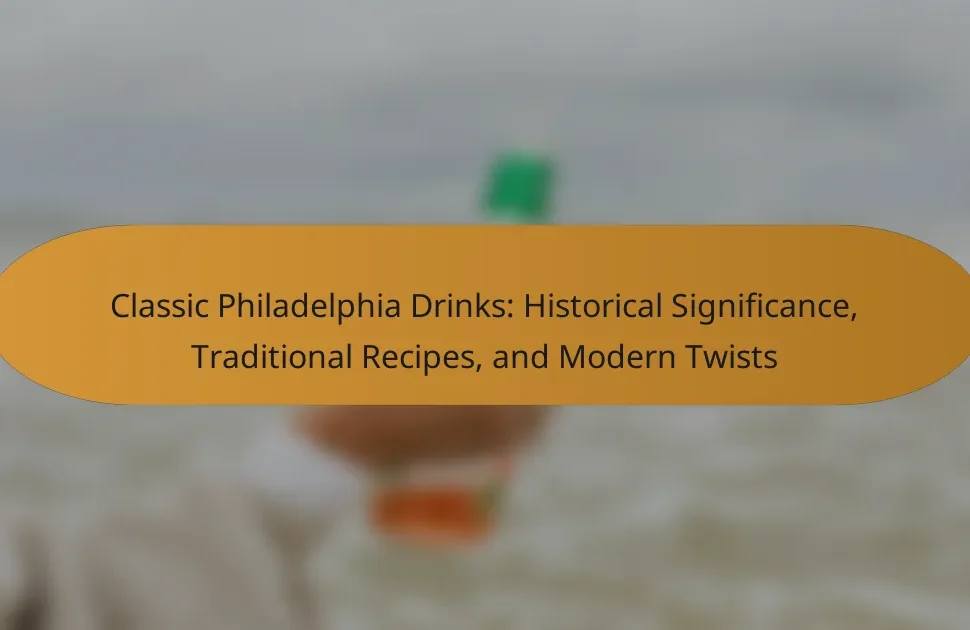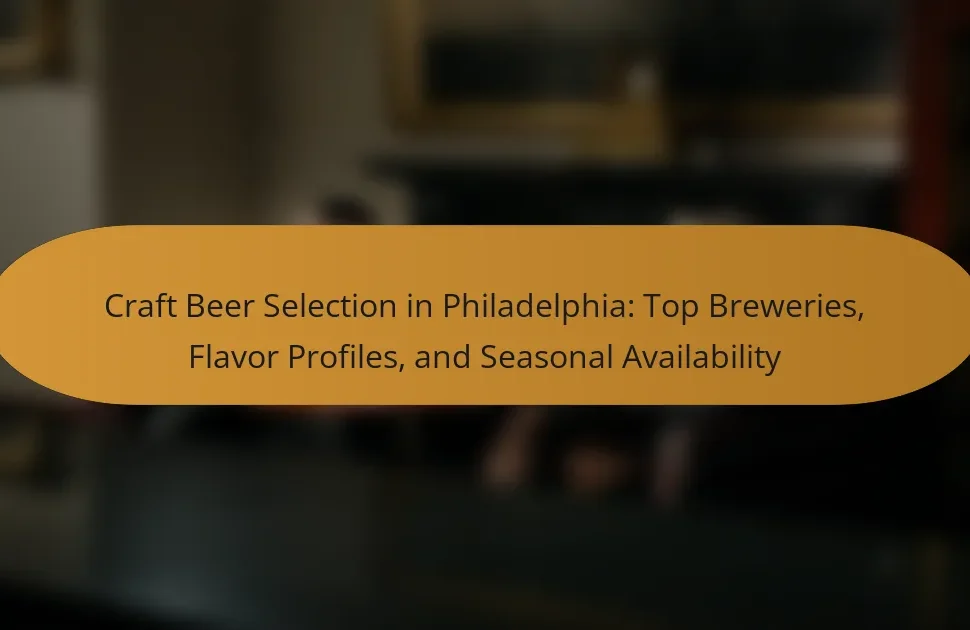
What are Beverage Pairing Recommendations in Philadelphia?
Beverage pairing recommendations in Philadelphia include local craft beers, wines, and cocktails that complement regional cuisine. For example, pairing a Philadelphia cheesesteak with a pale ale enhances the savory flavors. A soft pretzel is best enjoyed with a lager, which balances the saltiness. Additionally, pairing roast pork sandwiches with a fruity red wine can elevate the meal. The city’s diverse food scene also allows for innovative pairings, such as spicy dishes with sweet cocktails. Local experts suggest trying seasonal brews for optimal flavor matches. These recommendations are based on culinary traditions and local preferences in Philadelphia.
How do beverage pairings enhance food experiences?
Beverage pairings enhance food experiences by complementing and elevating flavors. The right beverage can balance the taste profile of a dish. For example, a rich red wine can enhance the flavors of a hearty beef dish. Conversely, a crisp white wine may brighten a seafood meal. Pairings also engage the palate, creating a more dynamic tasting experience. Studies show that beverages can influence flavor perception significantly. In a study published in the journal “Food Quality and Preference,” researchers found that wine can alter the perception of sweetness and acidity in food. Thus, beverage pairings are crucial for maximizing culinary enjoyment.
What factors influence successful beverage pairings?
Successful beverage pairings are influenced by factors such as flavor profiles, food texture, and acidity levels. Flavor profiles refer to the primary tastes in both the beverage and food. Complementary flavors enhance the overall dining experience. For instance, sweet wines pair well with spicy dishes. Food texture impacts the mouthfeel and overall balance. Creamy beverages can soften crunchy or dry foods. Acidity levels are crucial for balancing richness. High-acid beverages can cut through fatty foods, providing contrast. Understanding these factors leads to more harmonious pairings. Research shows that well-executed pairings can elevate the enjoyment of food and drink.
How does the local Philadelphia cuisine impact beverage choices?
Local Philadelphia cuisine significantly influences beverage choices by emphasizing regional flavors and ingredients. Dishes like cheesesteaks and soft pretzels often lead to the selection of specific beverages that complement their taste profiles. For example, the richness of a cheesesteak pairs well with local craft beers, which enhance the savory experience. Additionally, the acidity in certain wines can balance the saltiness of pretzels, making them a popular choice. Local breweries and distilleries produce beverages that reflect Philadelphia’s culinary heritage. The city’s focus on fresh, local ingredients also encourages the pairing of seasonal cocktails with traditional dishes. This synergy between food and drink enhances the overall dining experience, showcasing Philadelphia’s unique gastronomic identity.
Why is Philadelphia known for its unique beverage pairings?
Philadelphia is known for its unique beverage pairings due to its rich culinary heritage and diverse food scene. The city blends traditional flavors with modern culinary techniques. This results in innovative combinations that enhance the dining experience. Local ingredients often inspire these pairings, showcasing the region’s agricultural bounty. Popular beverages include craft beers, local wines, and artisanal sodas. Each pairing is carefully curated to complement specific dishes. For example, cheesesteaks are often paired with light lagers or IPAs. This thoughtful approach to beverage pairing has become a hallmark of Philadelphia’s dining culture.
What local beverages are popular for food pairings?
Local beverages popular for food pairings in Philadelphia include craft beers, local wines, and artisanal sodas. Craft beers from local breweries often complement dishes like cheesesteaks and pretzels. Local wines, particularly those from the surrounding Pennsylvania vineyards, pair well with a variety of cheeses and seafood. Artisanal sodas, such as those from local producers, can enhance the flavors of spicy foods and desserts. These beverages reflect Philadelphia’s rich culinary scene and local production. They are frequently recommended by food pairing experts for their compatibility with regional cuisine.
How do cultural influences shape beverage pairings in Philadelphia?
Cultural influences significantly shape beverage pairings in Philadelphia. The city’s diverse population brings various culinary traditions. Italian, Irish, and African American cultures, for instance, contribute unique flavor profiles. Italian cuisine often pairs well with wines, especially reds like Chianti. Irish dishes frequently complement stouts and ales, enhancing the dining experience. African American culinary traditions often feature sweet teas and fruit-based beverages. Local festivals and events celebrate these cultural heritages, further influencing beverage choices. This cultural mosaic creates a rich tapestry of pairing possibilities. Consequently, Philadelphia’s beverage landscape reflects its vibrant cultural diversity.

What are the best practices for pairing beverages with food?
The best practices for pairing beverages with food include considering complementary flavors and balancing textures. Pair beverages that enhance the dish’s primary flavors, such as matching acidity with acidity. For instance, a crisp white wine can complement a citrus-based dish. Additionally, consider the weight of the food and beverage. Light dishes pair well with lighter beverages, while rich foods can handle fuller-bodied drinks.
Matching sweetness levels is also crucial. Sweet wines can enhance desserts, while dry beverages can balance savory dishes. Regional pairings often work well, as local foods and drinks are designed to complement each other.
Finally, personal preference plays a significant role. Experimenting with different combinations can lead to delightful discoveries. These practices are supported by culinary experts and studies on flavor interactions, such as those found in “The Flavor Bible” by Karen Page and Andrew Dornenburg.
How can flavor profiles guide beverage pairings?
Flavor profiles guide beverage pairings by matching the taste characteristics of food and drinks. For instance, sweet foods pair well with sweet beverages to enhance flavor balance. Similarly, acidic foods often complement beverages with high acidity, like certain wines. Bitter foods can be offset by sweet or creamy drinks, creating a harmonious experience.
Research shows that pairing beverages with similar flavor profiles can enhance overall enjoyment. A study published in the Journal of Culinary Science & Technology found that complementary flavors lead to a more satisfying dining experience. Understanding these profiles allows for more informed and enjoyable beverage choices.
What are the key flavor profiles to consider?
Key flavor profiles to consider include sweetness, acidity, bitterness, and umami. Sweetness balances spicy or savory dishes. Acidity enhances freshness and cuts through richness. Bitterness can add complexity and depth. Umami enriches flavor and provides a savory experience. Each profile interacts with food differently, influencing overall taste. Understanding these profiles aids in creating harmonious beverage pairings.
How do acidity and sweetness influence pairing decisions?
Acidity and sweetness are crucial factors in beverage pairing decisions. Acidity enhances freshness and balances richness in food. Sweetness can soften acidity and highlight flavors. High-acid beverages, like Sauvignon Blanc, pair well with rich dishes. Sweet wines, such as Riesling, complement spicy foods effectively. Studies show that balanced acidity and sweetness improve overall taste perception. This balance leads to more enjoyable dining experiences.
What role do seasonal ingredients play in beverage pairing?
Seasonal ingredients enhance beverage pairing by providing fresh and vibrant flavors. They align with the natural growing cycles, ensuring peak taste and quality. For example, summer fruits like peaches and berries can complement light, refreshing cocktails. In winter, spices like cinnamon and nutmeg can enhance warm beverages. Seasonal ingredients also reflect local culinary traditions and promote sustainability. This connection to local agriculture supports regional economies. Research indicates that seasonal ingredients can elevate the overall dining experience by creating harmony between food and drink.
How can seasonal beverages enhance dining experiences?
Seasonal beverages can enhance dining experiences by complementing the flavors of seasonal dishes. These beverages often reflect the ingredients and themes of the season. For example, a pumpkin spice latte pairs well with autumn desserts. Additionally, seasonal drinks can evoke nostalgia and create a festive atmosphere. Research shows that pairing beverages with food can improve overall satisfaction. A study from the Journal of Culinary Science indicates that the right beverage can elevate a meal’s taste profile. Seasonal options also encourage exploration of local flavors and ingredients. This adds a unique element to dining, making experiences more memorable. Overall, seasonal beverages contribute significantly to the enjoyment of a meal.
What are examples of seasonal pairings in Philadelphia?
Examples of seasonal pairings in Philadelphia include pumpkin ale with roasted butternut squash soup in fall. Another pairing is summer shandy with grilled fish tacos during warmer months. In winter, hot spiced cider complements hearty stews. Spring brings a refreshing white wine paired with asparagus risotto. These pairings reflect local culinary traditions and seasonal ingredients.

What expert tips can improve beverage pairing skills?
Understand flavor profiles to enhance beverage pairings. Different beverages complement specific food flavors. For example, a crisp white wine can balance rich, fatty dishes. Consider acidity levels; acidic beverages often enhance savory foods. Pair sweetness in beverages with spicy dishes for balance. Explore regional pairings; local beverages may complement traditional dishes. Experiment with texture; a creamy drink can enhance a dish’s mouthfeel. Lastly, trust personal preferences; enjoyment is subjective in beverage pairing.
How can beginners start with beverage pairing?
Beginners can start with beverage pairing by understanding basic flavor profiles. Identify the primary flavors in the food, such as sweet, salty, or savory. Match these flavors with complementary beverages. For example, sweet foods pair well with sweet wines. Acidic foods benefit from crisp, refreshing drinks like sparkling water or dry white wine.
Consider the weight of the food and beverage. Lighter dishes pair well with lighter drinks. Heavier meals require more robust beverages. Experimentation is key; try different combinations to find personal preferences.
Research shows that pairing enhances the overall dining experience. A study by the University of California found that proper beverage pairing can elevate flavors by up to 30%.
What simple rules should beginners follow?
Beginners should follow a few simple rules for beverage pairing. First, consider the flavor profiles of both food and drink. Matching complementary flavors enhances the overall experience. Second, balance the intensity of the beverage with the dish. A bold wine pairs well with rich foods. Third, pay attention to acidity. High-acid beverages can cut through fatty dishes effectively. Fourth, experiment with regional pairings. Local beverages often complement regional cuisine. Lastly, trust personal preferences. Enjoyment is subjective, and personal taste should guide choices. Following these rules can improve beverage pairing outcomes significantly.
How can experimentation enhance beverage pairing knowledge?
Experimentation enhances beverage pairing knowledge by allowing individuals to discover unique flavor combinations. It encourages the exploration of diverse beverages with various foods. This hands-on approach leads to a deeper understanding of taste profiles. By testing different pairings, one can identify complementary and contrasting flavors. Research shows that sensory experiences improve flavor appreciation. A study published in the Journal of Culinary Science & Technology found that participants improved their pairing skills through practical experimentation. This method fosters creativity and confidence in making pairing decisions. Ultimately, it enriches the overall dining experience.
What common mistakes should be avoided in beverage pairing?
Common mistakes in beverage pairing include ignoring flavor profiles. Pairing beverages with similar flavors can lead to a dull experience. Another mistake is overlooking the intensity of dishes. A light dish requires a delicate beverage, while robust dishes need stronger drinks. Additionally, not considering the temperature of beverages can affect enjoyment. Serving a warm beverage with a cold dish can create an unpleasant contrast. Lastly, failing to balance sweetness and acidity can lead to unappealing combinations. For example, overly sweet drinks can clash with savory foods, diminishing the overall dining experience.
How can overthinking pairings lead to poor choices?
Overthinking pairings can lead to poor choices by causing confusion and indecision. When individuals analyze every possible combination excessively, they may overlook simpler, more effective options. This excessive scrutiny can create anxiety about making the wrong choice. Consequently, it may result in selecting beverages that clash with the food rather than complement it. Research indicates that overthinking can impair decision-making abilities, leading to less satisfying outcomes. A study published in the Journal of Consumer Research found that too many choices can overwhelm consumers, resulting in regret and dissatisfaction.
What are the pitfalls of ignoring personal preferences?
Ignoring personal preferences can lead to dissatisfaction in beverage pairing. When individuals do not consider their tastes, they may choose incompatible flavors. This results in an unpleasurable dining experience. Studies show that personal preferences significantly influence enjoyment and satisfaction. A survey by the Journal of Culinary Science found that 75% of respondents preferred meals aligned with their tastes. Additionally, overlooking preferences can diminish the overall culinary experience. It may also discourage individuals from trying new pairings in the future. Ultimately, personal preferences are essential for enhancing flavor and enjoyment in beverage pairing.
What are some recommended beverage pairing resources for Philadelphia residents?
Recommended beverage pairing resources for Philadelphia residents include local blogs, websites, and social media groups focused on food and drink. Websites like Philly Magazine and Eater Philadelphia often feature articles on beverage pairings. Local restaurants frequently publish pairing guides on their menus or websites. Social media platforms like Instagram have numerous Philadelphia-based influencers who share pairing tips. Additionally, the Philadelphia Wine Festival offers resources and events that focus on beverage pairings. These resources provide valuable insights into local preferences and trends in beverage pairing.
Beverage pairing recommendations in Philadelphia focus on local craft beers, wines, and cocktails that enhance the flavors of the city’s diverse cuisine. Key factors influencing successful pairings include flavor profiles, food texture, and acidity levels, which help create harmonious dining experiences. The article explores how Philadelphia’s culinary heritage and cultural influences shape beverage choices, providing expert tips for effective pairing strategies. Additionally, it highlights seasonal ingredients and popular local beverages that complement traditional dishes, ensuring a comprehensive understanding of beverage pairings in the region.




